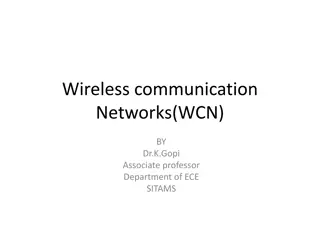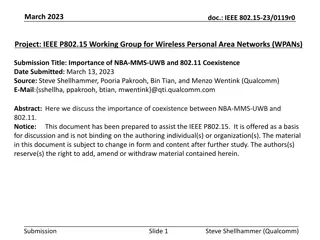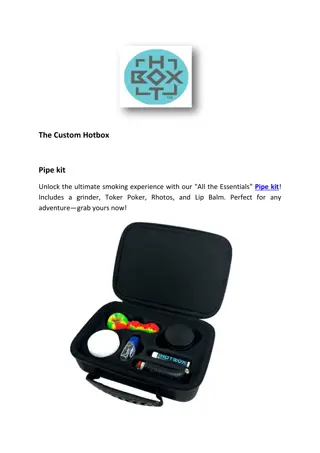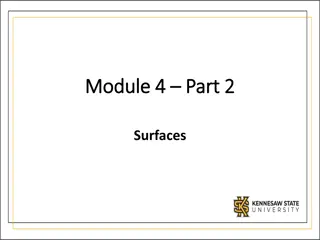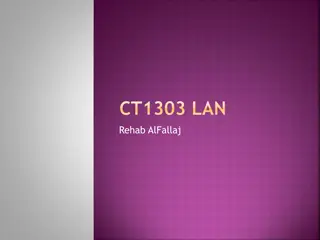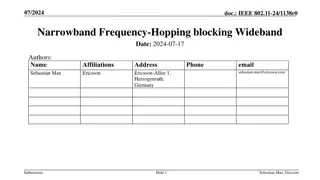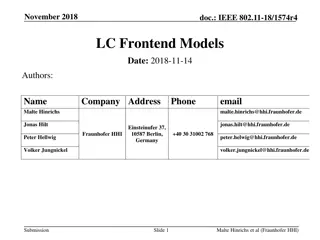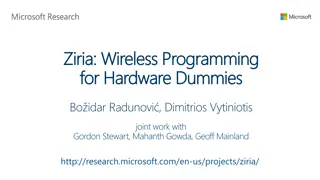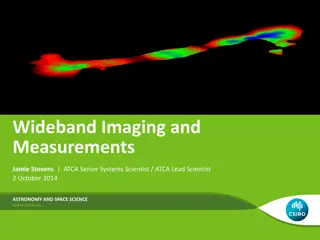Scrolls:Rolling Flexible Surfaces for Wideband Wireless
Revolutionizing wireless communication, the Scrolls project introduces rolling flexible surfaces for wideband wireless applications. With the expectation of 30 billion wireless devices by 2025, the project emphasizes standards and frequencies such as Cellular, Wi-Fi, and IoT. By offering a standard-agnostic, wideband frequency-tunable smart surface approach, Scrolls aims to enhance link quality and coverage efficiency across diverse spectrums. With a focus on simplifying wideband coverage provisioning and enabling simultaneous coverage enhancement for various standards, Scrolls presents a groundbreaking solution in the wireless communication domain.
Download Presentation

Please find below an Image/Link to download the presentation.
The content on the website is provided AS IS for your information and personal use only. It may not be sold, licensed, or shared on other websites without obtaining consent from the author.If you encounter any issues during the download, it is possible that the publisher has removed the file from their server.
You are allowed to download the files provided on this website for personal or commercial use, subject to the condition that they are used lawfully. All files are the property of their respective owners.
The content on the website is provided AS IS for your information and personal use only. It may not be sold, licensed, or shared on other websites without obtaining consent from the author.
E N D
Presentation Transcript
Scrolls: Rolling Flexible Surfaces for Wideband Wireless Ruichun Ma R. Ivan Zelaya Wenjun Hu
30 billion wireless devices expected by 2025! 30 billion wireless devices expected by 2025! * * Standards and Frequencies Cellular: 3~4GHz + mmWave -> 5G 1~2GHz -> LTE Diversification of standards & frequencies Wi-Fi: 2.4GHz + 5GHz -> 802.11n/ac/ax 6GHz -> 802.11ax/be How to ensure coverage efficiently? IoT: 2.4GHz -> BLE, ZigBee, Thread 900MHz -> LoRa, Z-Wave, RFID * Data source: https://www.statista.com/statistics/1101442/iot-number-of-connected-devices-worldwide/
Our approach: Our approach: Scrolls Scrolls Standard-agnostic, wideband frequency-tunable smart surface Enhancing link quality with signal-level reflection control Tunable, flexible surface elements to cover sub-6 GHz bands
Existing approach Existing approach LoRa Link (900 MHz) Wi-Fi Link (2.4/5/6 GHz) Cellular Link (1/2/3.7 GHz) Cellular Link (1/2/3.7 GHz) Wi-Fi Link (2.4/5/6 GHz) LoRa Link (900 MHz) To improve coverage Densely deployed standard- and frequency-specific infrastructure
Scrolls Scrolls simplifies wideband coverage provisioning simplifies wideband coverage provisioning Scrolls Enhanced Links Densely deployed standard- and frequency-specific infrastructure Simultaneous coverage enhancement for diverse standards and frequencies
How to tune operating frequency? How to tune operating frequency? Change the physical dimension of surface elements (antennas) ? + ~? Length 2 - Metallic reflector Half-wave dipole antenna Scrolls element Rolling a flexible copper strip!
Wideband frequency tunability Wideband frequency tunability Transmission Coeff. (dB) Transmission Coeff. (dB) Transmission Coeff. (dB) Transmission Coeff. (dB) 0 0 0 0 -10 -10 -10 -10 -20 -20 -20 -20 1cm Length -30 -30 -30 -30 1cm 2cm 1cm 2cm 6cm 1cm 2cm 6cm 16cm -40 -40 -40 -40 1 1 1 1 2 2 2 2 3 3 3 3 4 4 4 4 5 5 5 5 6 6 6 6 Frequency (GHz) Frequency (GHz) Frequency (GHz) Frequency (GHz) Turned off with 1cm length Continuously cover 6 GHz to 900MHz (1-16cm)
Surface assembly Surface assembly Balancing control granularity and complexity Stepper Motor Length Multiple elements onto one thin plastic sheet as one roll -- Roll-wise control
Surface assembly Surface assembly Assembling multiple rolls as composable panels Scalable and flexible deployment 45cm One panel: Several rolls and a Wi-Fi micro-controller Prototype of one panel ($40)
Hierarchical control architecture Hierarchical control architecture Master controller Can use existing infrastructure: Wi-Fi APs + an edge server Sub-controller On walls, tables or inside furniture Panels
How to set roll lengths How to set roll lengths Master controller RSSI (received signal strength indicator) minimal and accessible across devices Receiver Transmitter
How to set roll lengths How to set roll lengths Master controller Compute lengths and send commands Receiver Transmitter
How to set roll lengths How to set roll lengths Group testing procedure: Sample rolls to form a group. Sweep over potential lengths together. Receiver If no gain detected, turned off all rolls. If gain detected, test each roll. Transmitter
Handling multiple links Handling multiple links No harm to any link Targeting highest sum of SNR gain Receiver Can use other policies Transmitter
Evaluation setup Evaluation setup LoRa (915MHz) Wi-Fi (2.4GHz) 5GHz & 3.7GHz Panels and one endpoint Endpoint(s) Panels 4 m Locations of the other endpoint
Improving individual link SNR Improving individual link SNR 1 0.8 CDF Over Links Median gain : > 3 dB Max gain : 14 dB 0.6 915 MHz 2.4 GHz 3.7 GHz 5 GHz 0.4 0.2 0 0 2 4 6 8 10 12 14 RSSI Gain (dB) Received Signal Power Gain (dB)
Multiple concurrent links Multiple concurrent links 915MHz LoRa 2.4GHz Wi-Fi 3.7 GHz 5 GHz
Every Link benefits from Scrolls! Every Link benefits from Scrolls! 10 915 MHz 2.4 GHz 3.7 GHz 5 GHz 8 RSSI Gain (dB) 6 Median gain : 4 dB Max gain : 10 dB 4 2 0 1 2 3 4 5 Link Setup ID Link Setup
Conclusion Conclusion Problem: Standard- and frequency-specific infrastructure is complex and costly Solution: Scrolls: standard-agnostic, wideband frequency-tunable smart surface Results: Coverage improvement for links on different frequencies concurrently



